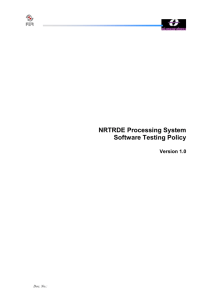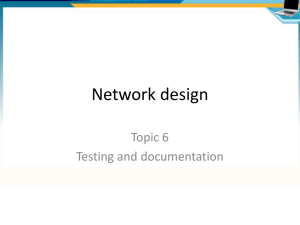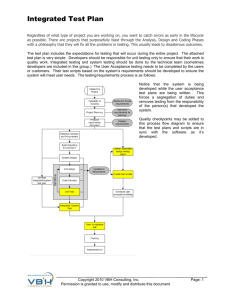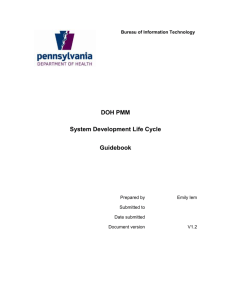XUS1654794file1_0.doc
advertisement
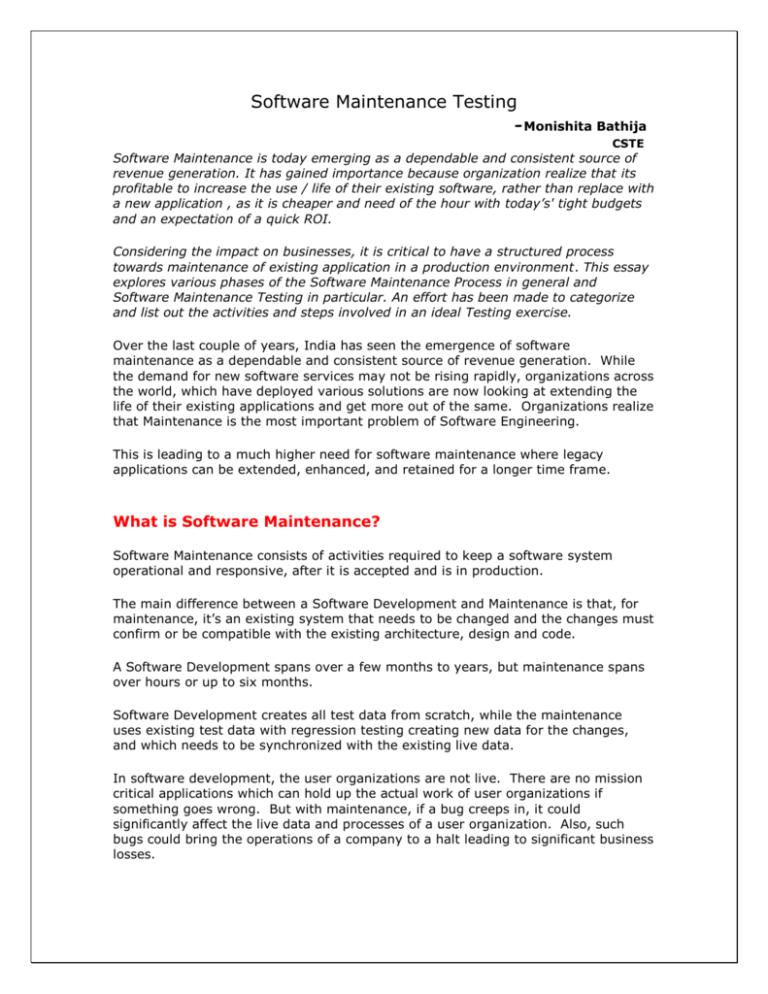
Software Maintenance Testing -Monishita Bathija CSTE Software Maintenance is today emerging as a dependable and consistent source of revenue generation. It has gained importance because organization realize that its profitable to increase the use / life of their existing software, rather than replace with a new application , as it is cheaper and need of the hour with today’s' tight budgets and an expectation of a quick ROI. Considering the impact on businesses, it is critical to have a structured process towards maintenance of existing application in a production environment. This essay explores various phases of the Software Maintenance Process in general and Software Maintenance Testing in particular. An effort has been made to categorize and list out the activities and steps involved in an ideal Testing exercise. Over the last couple of years, India has seen the emergence of software maintenance as a dependable and consistent source of revenue generation. While the demand for new software services may not be rising rapidly, organizations across the world, which have deployed various solutions are now looking at extending the life of their existing applications and get more out of the same. Organizations realize that Maintenance is the most important problem of Software Engineering. This is leading to a much higher need for software maintenance where legacy applications can be extended, enhanced, and retained for a longer time frame. What is Software Maintenance? Software Maintenance consists of activities required to keep a software system operational and responsive, after it is accepted and is in production. The main difference between a Software Development and Maintenance is that, for maintenance, it’s an existing system that needs to be changed and the changes must confirm or be compatible with the existing architecture, design and code. A Software Development spans over a few months to years, but maintenance spans over hours or up to six months. Software Development creates all test data from scratch, while the maintenance uses existing test data with regression testing creating new data for the changes, and which needs to be synchronized with the existing live data. In software development, the user organizations are not live. There are no mission critical applications which can hold up the actual work of user organizations if something goes wrong. But with maintenance, if a bug creeps in, it could significantly affect the live data and processes of a user organization. Also, such bugs could bring the operations of a company to a halt leading to significant business losses. The Maintenance Process The Maintenance Process begins when a ‘request for change, from the end-user, and ends when the system passes testing, and is accepted by the end-user. Finally it’s released for operation. The Process Flow can broadly be categorized as: Maintenance Assessment and Design Maintenance Construction Maintenance Testing Maintenance Transition Understand, recreate and assess the problem .Design the solution and plan for implementation Modify and implement changes Plan and prepare for testing, set up test environment and execute test cases and scenarios. Plan and install the system into production. Rest of this document would focus on the testing phase of Software Maintenance. Maintenance Testing The objective of the Testing stage is to ensure that the system is modified to take care of the business change, and the system meets the business requirements to a level acceptable to the users. It is quite well known that fixing bugs during maintenance quite often leads to new problems or bugs. This leads to frustration and disappointment for customers and also leads to increased effort and cost for re-work for the maintaining organization. This kind of “bug creep” usually occurs due to several reasons. The most common ones being: Integration: The maintenance engineer fixes a bug in one component and makes necessary changes for them. While doing so, the impact of this change in other components and areas is often ignored. The engineer then tests this component (which works fine) and proceeds to offer a patch to the customer. When the customer installs it, the problem reported is solved but new problems crop up. Deployment: The maintenance engineer has no clue of the deployment scenarios to be supported. Whether it is in terms of firewalls, proxy servers, client browsers, security policies, networking issues, etc which exist at the customer site. These are often ignored during the maintenance phase thus leading to a theoretical fix of the problem. Ideal setup: While fixing bugs, the maintenance engineer quite often as an “ideal setup”. All registry entries have been made. Database connections have been setup. Authorizations and permissions exist. Relationships have been set. But when a bug is fixed and deployed, the engineer has to realize that all these and many other system variables need to be checked and set. These and several such problems can be addressed by including Maintenance Testing in the processes for releasing maintenance patches. Broadly the various steps that make Maintenance Testing are: Prepare for Testing Conduct Unit Tests Test System Prepare for Acceptance Tests Conduct Acceptance Tests Prepare for Testing At this step all the preparatory work for testing is carried out. This will include creation of test data, files, procedures and plans. The Unit Test Plan will be created with details of the base level testing specifications for all the modules, or units, that will be changed and all new modules that will be constructed. This should also include the Test Cases and the test databases and files identified for the new construction. Also develop test scripts, which are scripts that can be run to test components both independently and in an integrated manner regressively. The scripts can simulate the business case of the end-user in a programmatic manner. These scripts can be maintained in a repository and run regressively on various builds released by the developer till expected results are consistently produced. Conduct Unit Tests At this step the Units changed and newly constructed are tested according to the Unit Test Plan previously created. Test System At this step the system tests prepared and conducted to verify that, as a whole, the system functions as specified. The System Test Cases developed should address the changes that are being made to the system. Assuming that the application is relatively new and has existing test cases, both the existing and new test cases are required to test the changes. Test Cases should be prepared to test changes or additions to any common components shared between systems or interfaces. The system test environment should be as similar as possible to the production environment, to make sure that the changes are compatible with the existing live system. The tests should verify the correct functioning of all aspects of the system as specified in the Business Request, including interfaces, usability, system security, performance and error recovery. Test results must be compared against the previous test results. This will be equivalent to regression testing. Scenarios for breakdown of the system must also be identified and tested. A reference to the User Guide and Operation Manual must be made to make sure and to verify the accuracy of the documentations. Prepare for Acceptance Tests At this step, prepare the system for acceptance tests and have the users of the system create the acceptance test scenarios. The objective of acceptance testing should be to ensure that the changes made to the system meet the business requirements to a level acceptable to system users. Conduct Acceptance Tests At this step the objective should be to ensure that the changes made to the system meet the business requirements to a level acceptable to system users. This Acceptance Test is usually conducted by the end-users and the Operation staff who support the system Of course, including Maintenance Testing as just one more “activity to be performed” will not deliver the desired results. The test engineers working on maintenance testing should be passionate about delivering a solution that solves the problems of customers and allows them to proceed seamlessly. Applied systematically and scientifically, maintenance testing can add significantly to the satisfaction of customers who are paying hefty maintenance contracts and could lead to increased trust between the customer and the maintenance provider.

